|
SETMA’s Policies on Advanced Directives
And Provider Opportunity to Complete this very important function
It is SETMA’s policy that all patients who are over fifty or all patients under fifty who are disabled or seriously and chronically ill be asked about their desires for end-of-life care. We phrase this request respectfully and compassionately. We say to the patient, “we want to know your desire for your care at the end of your life? Do you want to be resuscitated and/or placed on a ventilator?” In the typical, ambulatory care case, we add, “We do not expect this to be need now, but once we know your desires, we will know what to do when that time come, hopefully man years from now.”
If you want to know more about Advanced Directives, you can read the following articles on SETMA’s website:
SETMA providers confront Advanced Directives in six different places in our EHR:
- The Governance Board’s statement on Advanced Directive.
- The Medical Home Review Summary requirement to document Advance Directive
- The completion of the documentation for billing CMS for a Medicare Initial Preventive Physician Examination (IPPE) or for an Initial Annual Wellness Examination or a Subsequent Annual Wellness Examination which requires the completion of an Advanced Directive.
- HEDIS Care for Older Adults which includes the Advanced Directive.
- Care Transition Audit during preparation of the Hospital Care Summary and the Post Hospital Plan of Care
- Under Plan template on ambulatory care template, from the Plan Template, you access the Medical Legal button and there are two sample documents for Advanced Directives, one for “under 18” and one for “over 18”.
- Governance Board
The Governance Board’s PC-MH Mission, Vision, Goal, Access, End-of-Life includes a statement about SETMA’s policy on Advanced Directives. The full document can be found at: http://jameslhollymd.com/governance-board/pc-mh-mission-vision-goal-access-end-of-life. That document states SETMA’s respect of the patient’s advanced direction decision, in part that document states:
“Respecting Patent’s End-of-Life Decisions
“As part of a primary care medical home, SETMA initiatives the decision about end-of-life decisions, code status and the making of a living will or advanced directives. SETMA works with the patient to make rational decisions when further care is futile but respects the patient’s rights in they choose decisions with which we do not agree. If, in an inpatient setting, the patient’s family or medical power of attorney wishes to pursue futile, SETMA goes through a compassionate, patient-centric decisions making process consistent with medical ethics and the hospital by-laws. At this time the primary care medical home team is expanded to include clergy, case managers and others. SETMA has an advanced directive template which we offer to patients during the discussion about end-of-life issues. If a patient or family is not comfortable talking about end-of-life issues, we respect that and recommend speaking to their clergyman.”
On SETMA’s Medical Home Coordination Review Template, as seen on the template below outlined in green, there are opportunities to document:
- Code Status
- Advanced Directive Discussed
- Advanced Directive Completed
As stated above, SETMA providers have an option of printing a sample Advanced Directive for patients below 18 and above (see later in this document).
- The Medical Home Coordination Review and the Advanced Directive
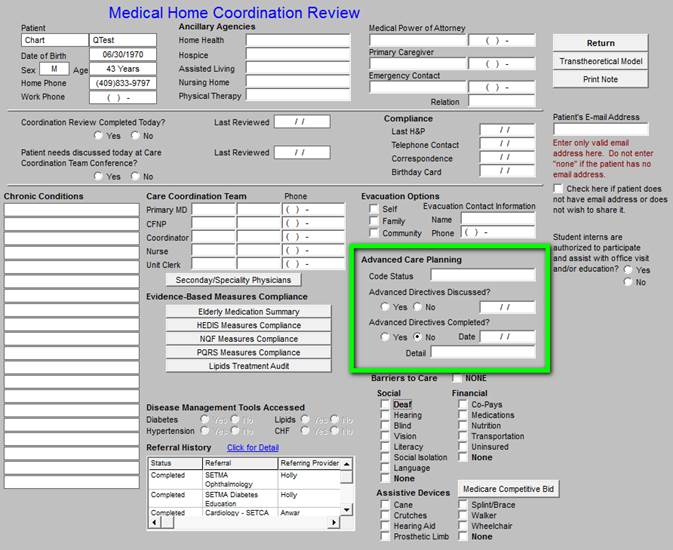
SETMA’s tutorial for the Medical Home Summary can be found at: Department of Care Coordination, Director of Care Coordination and Care Coordination Referral Template
That tutorial states: Whether Advanced Directive was discussed- one of the HEDIS measures for “care for older adults” requires that the advanced directive be on file, or that it be discussed at the current encounter. When you click the check box next to this function on the Medical Home coordination Review template, it will automatically result in your receiving credit for this function. If you check the box next to “Advanced Directive was discussed” or that “Whether the patient has an Advanced Directive”, the following HEDIS Measure (see below) will be credited for this patient’s Care for Older Adults record.
- HEDIS - Care for Older Adults and Advance Directives
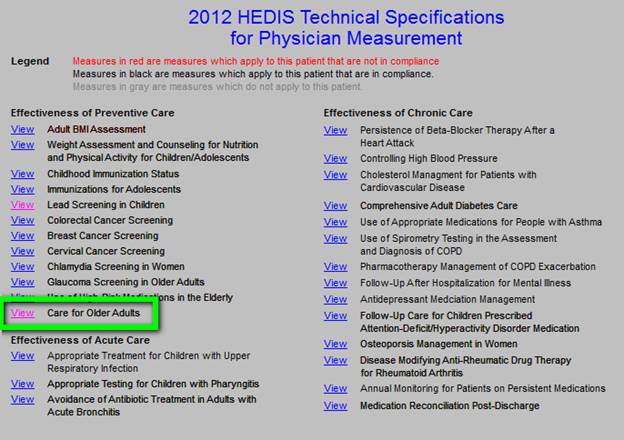
The Advanced Director is part of the HEDIS measure entitled, “Care for Older Adults.” As can be seen by the details which appear when the above button outlined in green is deployed, SETMA’s Medical Home summary and the HEDIS measure are identical. When one is completed all are completed simultaneously.

Advanced Care Planning is a HEDIS and a Medical Home requirement for older adults and it is a requirement of Medical Home. This function allows for the documentation of the patient’s:
- Code status
- Whether Advanced Directive was discussed at the present encounter*
- Whether the patient has an Advanced Directive
- Advanced Care Directive - details
- The Advanced Directive is required in completing the elements of the Medicare Preventive and medical Annual Wellness examination.
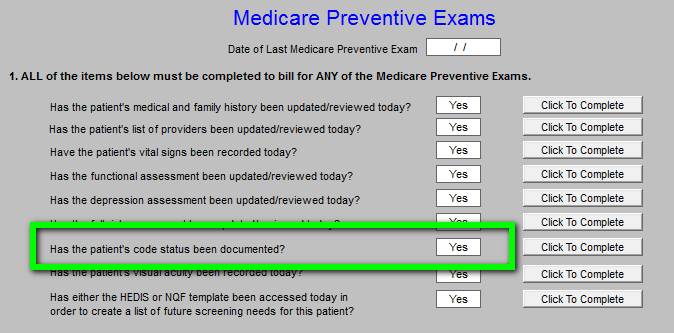
When a SETMA provider has been alert that a patient is eligible for one of these examinations, the specific elements which have not been fulfilled will appear in red. When one of those is the “code status,” the provider can click on the button entailed “click to complete,” next to the “patient’s the patient’s code status been documented.” The EMR will take the provider to where this needs to be documented. It can be completed and then the provider can continue with the other elements of the CPT code.
- Hospital Care Summary and the Post Hospital Plan of Care and Treatment Plan and the Advanced Directive
Previously called the “Discharge Summary,” the name has been changed to create a more functional name for a very important document. Part of SETMA’s Transitions of Care (all of that process can be reviewed at: Hospital Care Summary and Post Hospital Plan of Care and Treatment Plan Tutorial) is the Physician Consortium for Performance Improvement Transition of Care Quality Metric set.
As can be seen below, that measurement set is comprise of 14 elements, The one outlined in green is for “advanced directive.”
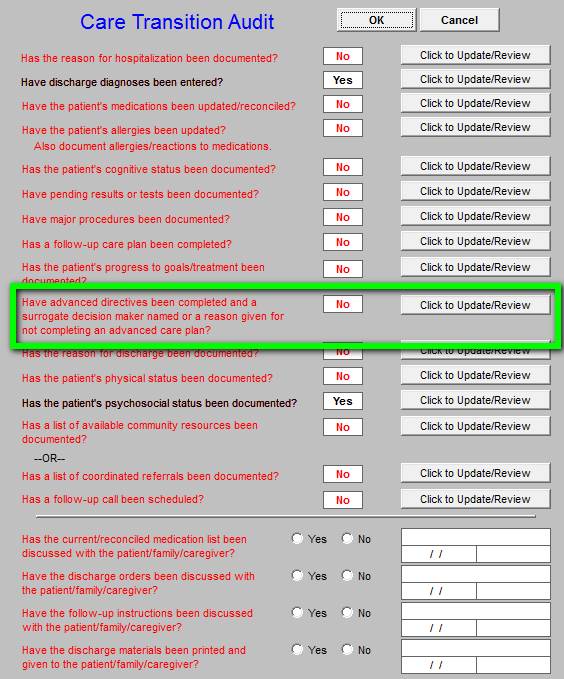
Every time a patient is discharged from the hospital, whether or not they have an advanced directive is measured. The following is an audit of SETMA’s providers’ performance on this measurement set for the year 2013. This is posted on our website at: Reporting by Type. Five years (2009-2013) of this data is public reported. In that time, SETMA has discharged over 20,000 patients and this audit has been complete 98.7% of the time.

- Finally, if a SETMA Provider goes to the Plan template there is a button entitled Medical Legal Documents.
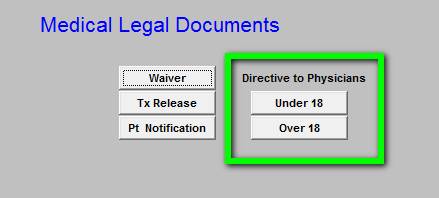
By clicking on either of these documents, a sample Advance Directive is printed for your patient. This is simplified by there being a laser printer in every examination room in SETMA’s six clinics.
|